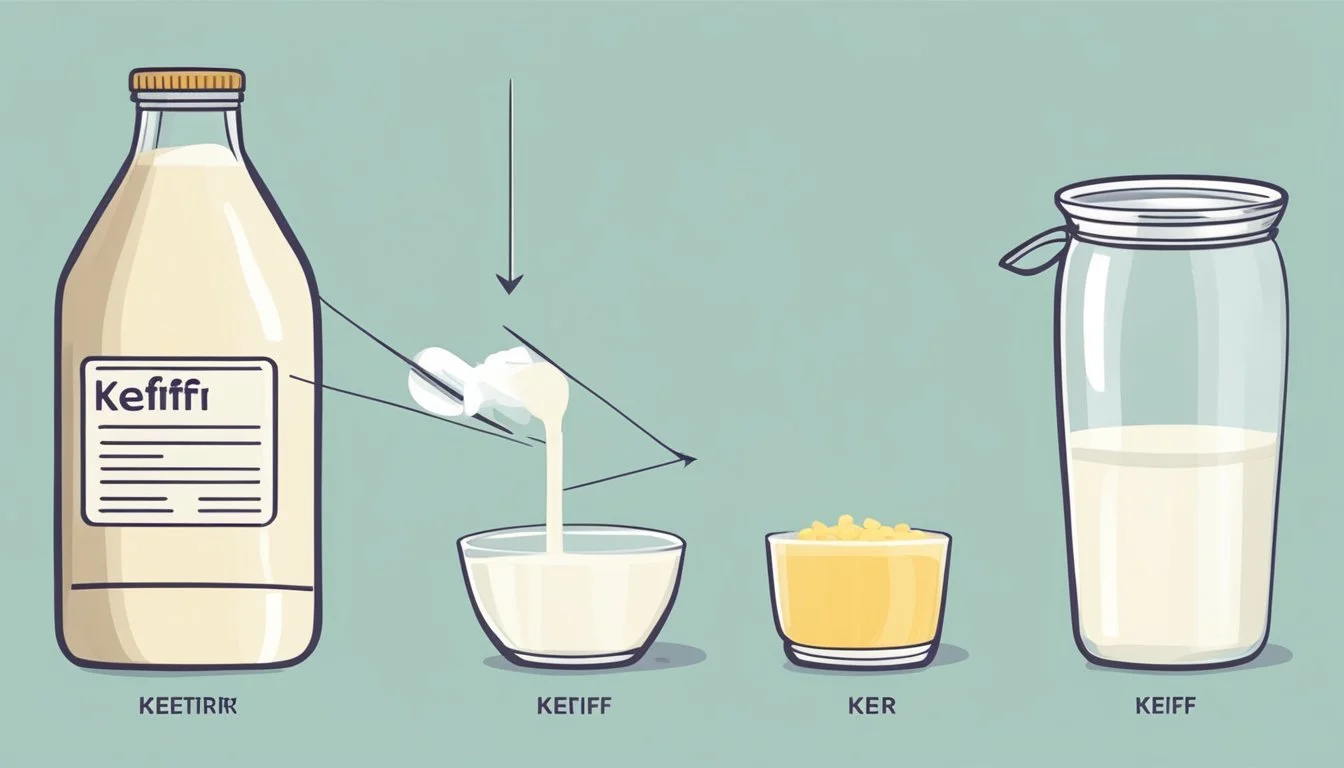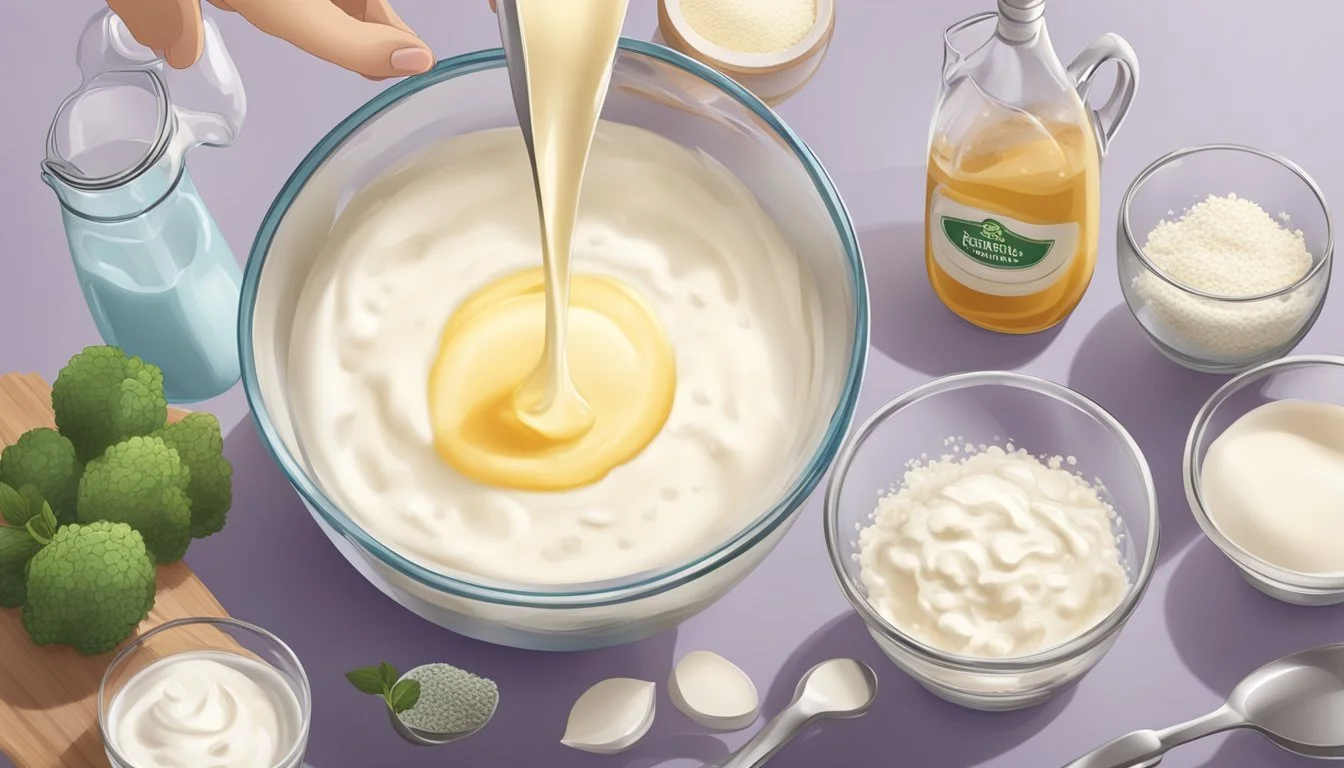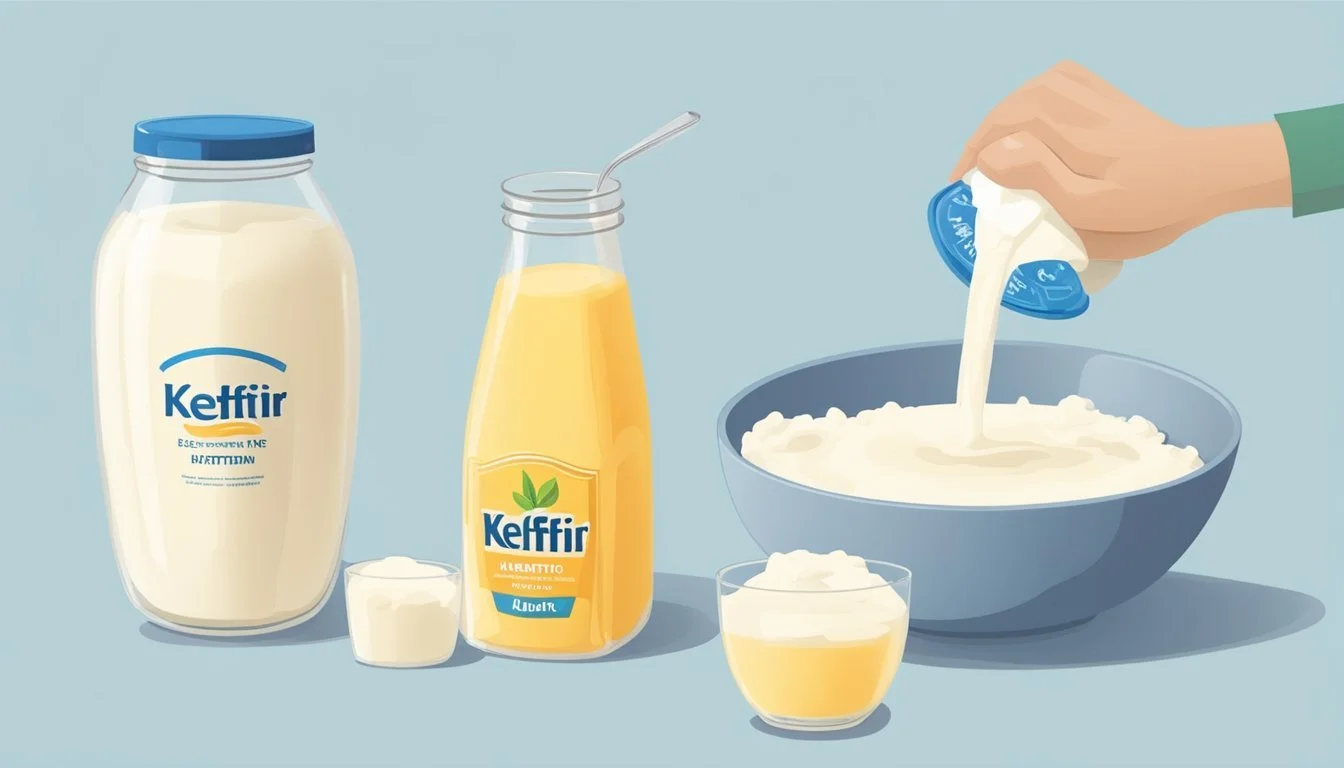How to Substitute Kefir for Buttermilk in Baking and Cooking
Kefir, a fermented dairy product often touted for its probiotic qualities, can also serve as an effective substitute for buttermilk in various recipes. While buttermilk has long been a staple in baking and cooking for its ability to add tenderness and a tangy flavor to dishes, kefir offers similar acidity and consistency. Due to its comparable characteristics, kefir can be used in a one-to-one ratio in place of buttermilk in most recipes, including popular items like pancakes, biscuits, and cakes.
The lactic acid bacteria present in both buttermilk and kefir cause the milk to ferment, giving them a similar tartness that is crucial for both taste and chemical reactions in cooking. This fermentation process also slightly thickens the liquids, providing the desired leavening effect when combined with baking soda. Before using kefir as a buttermilk substitute, it is important to assess the texture and consistency of the kefir, as it may be necessary to slightly adjust the quantity used or add additional liquid to achieve the optimal thickness for the recipe at hand.
Despite the slight differences in bacterial cultures and probiotic content, kefir's versatility makes it a suitable and easy-to-use alternative for buttermilk. With the rising popularity of kefir due to its health benefits, incorporating it into everyday cooking and baking provides a simple way to boost nutritional content without compromising on flavor or texture. When substituting, chefs and bakers can proceed with their recipes as usual, often without any significant alterations aside from swapping the buttermilk for kefir.
Understanding Buttermilk and Kefir
Buttermilk and kefir are both fermented dairy products with distinct cultures and production methods. They each offer unique nutritional profiles and a range of probiotic benefits.
Origins and Production
Buttermilk traditionally comes from the liquid left after churning butter. Modern buttermilk, however, is generally cultured, made by fermenting low-fat milk with lactic acid bacteria. Kefir is created through a fermentation process involving kefir grains, which are a symbiotic culture of bacteria and yeast (SCOBY). These grains are added to milk and ferment it over a period, usually 24 hours.
Production Differences:
Buttermilk: Fermented with lactic acid bacteria.
Kefir: Fermented with kefir grains containing a wider variety of bacteria and yeasts.
Nutritional Content
Both these dairy products are similar in terms of basic nutrition. However, they have subtle differences. Buttermilk tends to have slightly less carbohydrate content compared to kefir due to the presence of grains in the kefir which add extra carbs. Kefir may also have more fat content depending on the type of milk used in its production.
Nutritional Comparison (per 8-ounce serving):
Buttermilk: Generally has about 13 grams of carbohydrates.
Kefir: Generally provides around 8 grams of fat and more than 13 grams of carbohydrates.
Bacterial Composition
The health benefits of buttermilk and kefir largely stem from their bacterial composition. Buttermilk contains a limited variety of lactic acid bacteria. Kefir, on the other hand, can contain up to 60 strains of beneficial bacteria and yeasts, offering a more diverse range of probiotics. This diversity in kefir is due to the unique fermentation process and the symbiotic culture of bacteria and yeast present in the kefir grains.
Bacteria and Yeast Culture Details:
Buttermilk: Primarily lactic acid bacteria.
Kefir: Up to 60 strains of bacteria and yeast, including lactobacilli, lactococci, acetobacter, and saccharomyces.
Exploring the Taste and Texture Differences
When substituting kefir for buttermilk in recipes, one should consider how the differences in taste and texture can affect the final product. It's essential to recognize that each has its unique sensory profile, which can alter the flavor and consistency of your dish.
Flavor Profiles
Kefir’s flavor is distinctly tangy and can be more sour than buttermilk, attributed to its diverse probiotic content. In contrast, buttermilk presents a mildly tangy flavor, which is less pronounced. The specific profile of each can influence the taste of baked goods or dressings where either is used.
Kefir: More pronounced tanginess; sharpness varies by fermentation.
Buttermilk: Gentle tartness; often described as "subtle."
Consistency Considerations
The texture of kefir and buttermilk can vary widely, with kefir generally being less thick than buttermilk. This difference in viscosity may impact the texture of baked products or sauces.
Kefir: Ranges from slightly to very runny, similar to drinkable yogurt.
Buttermilk: Traditionally thicker, especially if it's the cultured variety, providing a richer body.
Substituting Kefir for Buttermilk in Recipes
Substituting kefir for buttermilk can be a straightforward process, especially when the right ratios are used and the unique properties of each are considered, ensuring successful results in both baking and cooking.
General Substitution Guidelines
One can substitute kefir for buttermilk in a one-to-one ratio in most recipes. This means if a recipe calls for one cup of buttermilk, one can use one cup of kefir as a direct replacement. The texture and consistency of kefir, which is similar to buttermilk, allows for this seamless substitution without significant adjustments to the recipe.
Adjustments for Baking
When baking, the acidity of buttermilk is often utilized to activate leavening agents like baking soda. Kefir, which is also acidic, can similarly activate these agents. However, kefir’s acidity might vary slightly compared to buttermilk; as such, a slight adjustment may be necessary.
For every cup of kefir used, consider adding an extra 1/8 teaspoon of baking soda to ensure proper rise.
If the kefir is less tangy than buttermilk, a tablespoon of lemon juice or white vinegar per cup can be added to enhance the flavor.
This fine-tuning helps baked goods achieve the desired texture and taste that buttermilk typically provides.
Non-Baking Applications
In non-baking contexts, such as marinades or dressings, kefir is an excellent substitute without the need for adjustments. The creamy texture and tartness enhance these recipes similarly to buttermilk.
Dressings and marinades: Direct substitute following the one-for-one ratio.
Creaminess in soups or sauces: Utilize kefir as a thickening agent and for its tangy flavor profile.
For recipes where buttermilk’s thicker consistency is needed, mix kefir with a thickening agent like sour cream or yogurt to achieve the desired thickness.
Adapting to Different Types of Dishes
When substituting kefir for buttermilk, the cook should consider the role buttermilk plays in the recipe to make a successful replacement. Here is how to incorporate kefir in varying types of dishes:
Baked Goods
In biscuits and pancakes, buttermilk is often used to add a slight tang and to react with leavening agents, aiding in rise and fluffiness. To substitute with kefir, simply use a one-to-one ratio. For every cup of buttermilk the recipe calls for, use one cup of kefir.
Biscuits: Expect kefir to produce a similar tenderness and depth of flavor.
Pancakes and waffles: Kefir will maintain the desired fluffiness and can add a richer taste.
Savory Dishes
When preparing savory dishes like fried chicken, buttermilk acts as a tenderizer in marinades. Kefir can also tenderize effectively due to its acidic nature.
Marinades: Use equal parts kefir in place of buttermilk to soak the chicken, letting it rest preferably overnight.
Dressings: Kefir works well in creamy dressings, providing a consistency like that of buttermilk.
Sweet Treats
For sweet treats like buttermilk pancakes or other desserts that require a dairy product for moisture and flavor, kefir is an excellent option.
Buttermilk pancakes: Substitute equal parts of kefir to achieve similar taste and texture.
Cakes: Kefir can be used as a direct substitute in cakes, contributing to a moist crumb.
Use these guidelines to seamlessly integrate kefir into your recipes, maintaining the integrity of your favorite dishes while embracing the versatility of this cultured dairy product.
Considerations for Dietary Restrictions
When substituting kefir for buttermilk, individuals with dietary restrictions must consider alternatives that accommodate their specific needs. Whether due to a vegan lifestyle or a preference for low-fat and reduced-sugar options, finding the right substitute is crucial to maintaining both the recipe's integrity and dietary compliance.
Vegan and Non-Dairy Alternatives
For those who follow a vegan diet or seek non-dairy alternatives, plant-based milks offer a viable substitution. The key to a successful vegan buttermilk substitute lies in the acidification of the plant-based milk, which can be achieved through the following methods:
Coconut milk: Mix 1 cup of coconut milk with 1 tablespoon of lemon juice or vinegar.
Almond milk: Combine 1 cup of almond milk with 1 tablespoon of lemon juice or vinegar.
Soy milk: Stir 1 tablespoon of lemon juice or vinegar into 1 cup of soy milk.
Cashew milk: Add 1 tablespoon of lemon juice or vinegar to 1 cup of cashew milk.
Allow the mixture to sit for a few minutes until it curdles and thickens, which emulates the consistency and tanginess of buttermilk.
Low-Fat and Reduced-Sugar Options
For individuals looking to reduce their fat or sugar intake, there are alternatives that can be employed without sacrificing flavor:
Low-fat milk: Opt for low-fat or skim milk combined with lemon juice or vinegar to decrease the overall fat content, following the same method as with the plant-based milks.
Unsweetened milk varieties: Utilize unsweetened variants of almond, soy, or cashew milk to control sugar content in recipes, ensuring to add the acid to achieve the desired buttermilk effect.
It is important to note that the texture and taste of the final product may vary slightly with these substitutions, but they are generally effective in mimicking traditional buttermilk while adhering to specific dietary guidelines.
Fine-Tuning Kefir Substitutions
When substituting kefir for buttermilk in recipes, one should consider the acidity and fat content to achieve the desired texture and flavor.
Acidic Additions
To mimic the natural tang of buttermilk, one may need to enhance the acidity of kefir. Adding 1 tablespoon of an acidic substance—like lemon juice or vinegar—to each cup of kefir can achieve this. Alternatively, using apple cider vinegar will not only provide the needed acidity but also add a subtle fruitiness.
Lemon Juice: Provides a bright, fresh tang.
White Vinegar: Offers a clean acidic lift.
Apple Cider Vinegar: Gives a fruity note and high acidity.
Acidic Agent Quantity per Cup of Kefir Lemon Juice 1 tablespoon White Vinegar 1 tablespoon Apple Cider Vinegar 1 tablespoon
Fat Content Adjustments
Kefir generally contains a higher fat content than buttermilk. If a recipe requires the richness of fat for moisture and flavor, kefir is adequate. However, if one aims for a lighter texture, kefir can be thinned with regular milk or a blend of milk and cream of tartar. Another approach is to mix kefir with plain yogurt or low-fat milk to achieve a similar consistency to buttermilk, balancing both the richness and the characteristic tang.
Full-Fat Kefir: Directly substitute for a richer product.
Thinned Kefir with Milk: For less fat and a lighter result.
Kefir with Plain Yogurt: To maintain thickness with controlled fat.
Fat Adjustment Mix Ratio Regular Milk 1 part milk to 3 parts kefir Milk and Cream Tartar 1 3/4 tsp cream tartar to 1 cup Plain Yogurt Mix with kefir to desired fat %
The bacteria in kefir are similar to those used in the fermentation of buttermilk, therefore, it’s an excellent buttermilk substitute. The chef should adjust for kefir's higher fat content and potentially lower acidity to ensure the substitution maintains the integrity of the original recipe.
Maximizing the Benefits of Kefir
Kefir stands out as a versatile dairy product, known for its probiotic content and nutritional value. This section explores how substituting kefir for buttermilk can not only work in recipes but also enhance your dietary intake with its health-promoting properties.
Probiotic Advantages
Kefir is a fermented milk drink teeming with various probiotic strains. Unlike buttermilk, which can have a limited number of bacterial cultures, kefir typically contains a diverse community of friendly bacteria and yeasts, which can include up to 60 different strains. These probiotics play a significant role in maintaining a healthy gut microbiome. Consuming kefir can therefore introduce a wider variety of beneficial microorganisms to your system compared to buttermilk.
Digestive Health
The regular consumption of kefir as a substitute for buttermilk contributes to better digestive health. The plethora of friendly bacteria found in kefir aids in breaking down foods and absorbing nutrients effectively due to its rich probiotic profile. Additionally, the proteins in kefir are partially digested during the fermentation process, which can make them easier to absorb. Kefir also tends to have a higher fat content that includes healthier fats, which, in moderate amounts, are important for proper bodily functions. By integrating kefir into one's diet, individuals can support their digestive system and improve nutrient uptake.
Storing and Preserving Both Dairy Products
Proper storage is crucial for maintaining the freshness and nutritional benefits of kefir and buttermilk. Both are dairy-based, fermented milk drinks requiring specific conditions to ensure their longevity and preservation of their rich content in nutrients like calcium and potassium.
Refrigeration Best Practices
Kefir and buttermilk should be stored in the refrigerator immediately after purchase or use. They thrive best at temperatures between 35°F and 40°F. Always keep them in their original container or transfer them to an airtight container to prevent contamination and the absorption of other flavors and odors present in the refrigerator.
Kefir: It's essential to keep kefir tightly sealed, as it is a fermented product containing live cultures. The SCOBY (symbiotic culture of bacteria and yeast) present in kefir can be affected by external contaminants.
Buttermilk: After each use, seal buttermilk containers properly. Exposure to air can reduce its shelf life and quality.
Extending Shelf-Life
To extend the shelf-life of these perishable products, one should take extra care in handling and storing them correctly.
Kefir can sometimes be frozen, but it may alter the texture and possibly the probiotic content. To freeze, pour it into ice cube trays for portion use later on.
| State | Kefir | Buttermilk |
|-----------------|---------------------------|---------------------------|
| Fresh | Refrigerate immediately. | Refrigerate immediately. |
| Post-Opening | Seal tightly. | Seal tightly. |
| Approaching Use-by Date | Consume or freeze if it's an option. | Use promptly, freezing not recommended. |Buttermilk generally does not freeze well due to potential separation, but one can extend its life slightly by keeping it at the back of the fridge, where temperatures are most constant, away from the door.
Understanding Variants and Derivatives
This section provides insights into the various forms of buttermilk and kefir available for use in cooking and baking, highlighting both cultured and dehydrated options.
Cultured Milk Varieties
In the culinary world, buttermilk traditionally refers to the liquid left after churning butter from cultured cream. Modern buttermilk, however, is cultured milk, fermented with lactic acid bacteria, much like kefir. Kefir is a fermented milk drink with a slightly tangy taste, akin to buttermilk, and ferments with not only lactic acid bacteria but also yeast, contributing to its rich probiotic profile.
When substituting unflavored kefir for buttermilk in recipes, one can use them interchangeably on a one-to-one basis. Both impart a similar creaminess and acidity essential for leavening and flavor in baked goods. They are suitable for tenderizing meat and can be used in marinades. However, kefir's thinner consistency might slightly affect the texture in some recipes.
Powdered and Concentrated Forms
Buttermilk powder, a dehydrated form of buttermilk, provides a longer shelf life and is convenient for those who do not have access to fresh buttermilk. To substitute, one should reconstitute the powder with water following the manufacturer's directions or add the powder directly to dry ingredients and include the appropriate amount of liquid in the recipe.
Buttermilk Product How to Use in Recipes Buttermilk Powder Reconstitute with water or mix with dry ingredients Kefir Use as liquid ingredient, akin to fresh buttermilk
Though not directly related to buttermilk, products like Greek yogurt or acidified milk—milk mixed with an acid like lemon juice or vinegar—can also serve as substitutes in recipes calling for buttermilk. All alternatives, including whole milk and kefir, should be unflavored and possibly diluted to mimic the consistency of buttermilk. Fermentation is key to achieving the characteristic tang and leavening abilities of these dairy derivatives in cooking and baking applications.
Customizing Kefir to Personal Taste
Customizing kefir to fit personal preferences can enhance its role as a buttermilk substitute in cooking and baking. It allows for adjustments in flavor complexity and texture consistency, catering to specific tastes and dietary needs.
Incorporating Flavors
To tailor the taste of kefir, the addition of various ingredients can transform its flavor profile. While plain kefir offers a tart and tangy base, one can introduce sweetness or fruitiness as desired.
Sweetness: Add natural sweeteners like honey or maple syrup to subtly sweeten kefir.
Fruit Infusion: Blend in fresh or frozen fruits for a naturally flavored twist.
Herbs and Spices: Infuse with herbs like mint or spices such as cinnamon to add depth.
Consider the impact on carbohydrates when adding sweeteners or fruits, as these can increase the sugar content of the kefir. For those managing gluten sensitivity, ensure any flavorings are gluten-free.
Adjusting Texture and Consistency
The desired thickness of kefir can vary from one recipe to another. Some may prefer a thicker substitute for buttermilk, reminiscent of its traditionally creamy texture, while others may opt for a lighter consistency.
To Thicken: Blend in plain yogurt or use full-fat kefir to add creaminess.
To Thin: Mix with a small amount of skim milk, which will reduce the overall fat content and create a lighter, pourable consistency.
These modifications not only affect the texture but also alter the nutritional profile, specifically the fat and carbohydrates content. Kefir in its unaltered form has a consistency slightly thinner than traditional buttermilk, so adjustments should be made with care to preserve the desired attributes in the final dish.








